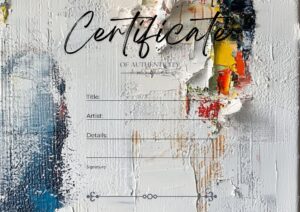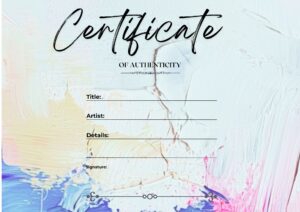-

- Home
- Art Styles
- Abstractionism
- Abstract Expressionism
- Action Painting
- Art Deco
- Art Nouveau
- Bauhaus
- Cartoon Style Illustration
- Classical & Traditional
- Colour-field Art
- Conceptual
- Constructivism
- Cubism
- Dadaism
- Expressionism
- Fauvism
- Futurism
- Illustration
- Impressionism
- Minimalism
- Modern Impressionism
- Naïve Art
- Op art
- Painting
- Photography
- Photorealism
- Pop Art
- Portraiture
- Post-Impressionism
- Realism
- Romanticism
- Sculpture
- Stylized Illustration
- Surrealism
- Urban
- Art Medium
- Art Subjects
- Visitor Guide
- dgwt_wcas_search_box
[vc_row css=”.vc_custom_1743262793898{margin-top: 25px !important;}”][vc_column][handmade_banner layout_style=”style1″ image=”5118″ height=”200″ border_color=”#FFFFFF” text_color=”#FFFFFF”][/vc_column][/vc_row][vc_row css=”.vc_custom_1743265491609{margin-top: 25px !important;}”][vc_column][vc_column_text css=””]The Importance of a Certificate of Authenticity (CoA) for Emerging Artists
As an undiscovered artist selling on an art marketplace, establishing credibility is key to building trust with buyers. One of the best ways to do this is by including a Certificate of Authenticity (CoA) with every piece of artwork you sell. A CoA reassures buyers that they are purchasing an original piece directly from you, helping to validate your work and reinforce your professionalism in the art market.
Why is a Certificate of Authenticity Important?
Navigating the art market can feel overwhelming, especially if you’re new to selling your work. While creativity is your passion, the business side of art—such as marketing and building a professional reputation—can be unfamiliar. A CoA is a simple but effective tool that can help you establish yourself as a serious artist. It signals to buyers that your work is authentic, valuable, and a worthwhile investment.
For both artists and collectors, certificates of authenticity are essential for maintaining the legitimacy and value of artwork. They also provide protection against fraud and misrepresentation, ensuring that buyers can trust their purchase.
What is a Certificate of Authenticity?
A Certificate of Authenticity serves as an official document that confirms the legitimacy of a piece of art. It is essentially a professional sales receipt that proves the artwork was created by you. Many buyers appreciate having this document as it assures them that they are purchasing a genuine and unique piece. If a buyer does not receive a CoA with their purchase, they may question the authenticity of the work or the professionalism of the artist.
What to Include in Your Certificate of Authenticity
Although the details on a CoA may vary depending on the artwork, here are the key elements to include:
- Artist’s Signature (Preferably hand-signed, not photocopied)
- Title of the Artwork
- Date of Creation
- Dimensions of the Piece
- Medium and Materials Used
- Edition Number (If it’s part of a limited edition series)
- Additional Details (Optional: Some artists include contact details to build future connections with buyers)
By providing a CoA with every piece of artwork, you are protecting both yourself and your buyers. Even if you don’t intend to sell a particular piece immediately, having a CoA prepared ensures that all important details are documented should you decide to sell it in the future.
Protecting Your Authenticity
While a CoA is an important tool, it’s important to remember that these certificates are not legally binding, and unfortunately, fraudulent CoAs do exist in the art world. To help ensure your authenticity and simplify the process, we are offering our members an exclusive, professionally designed CoA template.
Using this template will give you peace of mind and reinforce the legitimacy of your work, helping you build a strong reputation as an artist. Including a CoA with your artwork not only adds value to your pieces but also helps you stand out in the competitive online art marketplace.
Here are nine designed templates for a Certificate of Authenticity. If you like any and would like one or more sent to you please complete the contact form at the bottom with your request and the template you’d like us to send you.
Examples:
Certificate 1 Certificate 2 Certificate 3



Certificate 4 Certificate 5 Certificate 6



Certificate 7 Certificate 8 Certificate 9



Creating a Certificate of Authenticity (COA) ensures that your artwork is recognized as genuine. A well-crafted COA adds credibility, protects against forgery, and reassures buyers. Here’s a step-by-step guide to making one from scratch.
Step 1: Gather Essential Information
A good COA should contain:
- Title: “Certificate of Authenticity” at the top.
- Item Details: Name, description, and key characteristics.
- Creator/Issuer Information: Artist, brand, or certifying entity.
- Unique Identifier: Serial number, SKU, or holographic sticker.
- Verification Signature: Signature of the creator, manufacturer, or expert.
- Issue Date: When the certificate was issued.
- Statement of Authenticity: A formal declaration confirming the item’s authenticity.
Step 2: Design the Layout
Your COA should be visually appealing yet professional. Consider:
-
Font Choice: Use elegant, readable fonts (e.g., serif for a classic look, sans-serif for modern)
-
Borders & Watermarks: Prevent counterfeiting with unique borders or background patterns
-
Paper Type: If printing, use high-quality, thick paper (e.g., parchment, cardstock)
-
Security Features: Holographic stickers, embossed seals, or QR codes for extra protection
Step 3: Write the Certificate Text
Example template:
Certificate of Authenticity
This certifies that [Item Name], created by [Artist/Brand Name], is an original and authentic work. This item is uniquely identified by [Serial Number] and was issued on [Date].
This certification guarantees the authenticity of the item and ensures it meets the highest standards.
[Authorized Signature]
[Issuer’s Name & Contact Information]
Step 4: Print the COA
-
For printed COAs, use high-quality printing methods (e.g., foil stamping, embossing).
Consider using online verification platforms like Verisart or ArtTrust for added credibility.
Final Tips:
✔ Keep a record of issued COAs for future reference.
✔ Use unique numbering to prevent duplicates.
✔ Clearly state whether the certificate is transferable or remains with the original buyer.
By following these steps, you’ll create a professional, trustworthy Certificate of Authenticity that enhances your item’s value and credibility.
[/vc_column_text][/vc_column][/vc_row][vc_row css=”.vc_custom_1743268764159{margin-top: 25px !important;}”][vc_column][contact-form-7 id=”5120″][/vc_column][/vc_row]